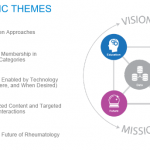 There was a time when medical textbooks were the ultimate resource for information in the field. The modern age of the U.S. medical textbook began in the 1920s and was fully established by the 1960s. Internal medicine saw the appearance of textbooks by Russell Cecil (1927) and Tinsley Harrison (1950), with specialty textbooks by Goodman and Gilman (pharmacology, 1941), Hollander/McCarty/Comroe (arthritis, 1940), Wintrobe (hematology, 1942) and Eugene Braunwald (cardiology), among others.
There was a time when medical textbooks were the ultimate resource for information in the field. The modern age of the U.S. medical textbook began in the 1920s and was fully established by the 1960s. Internal medicine saw the appearance of textbooks by Russell Cecil (1927) and Tinsley Harrison (1950), with specialty textbooks by Goodman and Gilman (pharmacology, 1941), Hollander/McCarty/Comroe (arthritis, 1940), Wintrobe (hematology, 1942) and Eugene Braunwald (cardiology), among others.
In 1960, Dr. Cecil wrote:
I think we must assume that textbooks are still essential to medical education …. The methods of teaching medicine will undoubtedly change as new ideas and new techniques on pedagogy are developed in university circles, but there will always be a need of authoritative treatises on every aspect and every field of medical knowledge.1
For many of us in rheumatology, the Kelley and McCarty arthritis volumes, which were updated every five years or so, were considered reliable repositories for the final say on rheumatoid arthritis, osteoarthritis and the like for interested readers. Specific disease topics were covered by monographs, which included Dubois’ textbook on lupus erythematosus.
However, a quiet change in the publishing field, has taken place over the past 20 years—one not being mentioned in any peer-reviewed publications. Since 2000, numerous medical textbook titles have disappeared, and readership has shifted to sources available on the internet, which includes services like UpToDate and which are frequently updated to highlight new information.
This trend is similar to what has occurred in the larger textbook publishing industry, which reported a peak in printed textbooks in 2015.2 Sales of traditional medical textbooks have been stable internationally, but have decreased in North America by over 50%, and they have become prohibitively expensive.
An explosion of ebooks that cover rheumatology topics has occurred, with only a few hundred copies actually printed. Some chapters of specific textbooks can now be downloaded without having to buy the whole book, along with slide sets for specific tables and figures. Although this is more convenient to the medical practitioner, the quality of information presented, and recommendations and nuances from those who have spent years in the field, has not kept up with the times.
At the same time, the traditional medical textbook has aged. Many current volumes are edited by the same group of people who have done so for about 30 years. This has tended to result in a relative lack of inclusivity and diversity of international authors, as well as young and promising investigators, as chapter authors or section editors, a problem recognized in journal editorial boards as well.3 These authors lack innovation in coming up with new chapter titles or formats. There is a lack of strategic planning, and many traditional textbooks are becoming stale.
Most importantly, professional U.S. rheumatology societies have not been really involved in the development or organization of the rheumatology textbook.4
Dubois’ Lupus Erythematosus & Related Syndromes
To understand the future of textbooks, we have to delve into their history. For an example, let’s examine Dubois’ Lupus Erythematosus and Related Syndromes.
Born in Newark, N.J., Edmund Lawrence Dubois (1923–85) received a bachelor’s degree from Johns Hopkins University, Baltimore, in 1943, served in the U.S. Army during the World War II while attending medical school and completed a pathology fellowship at Los Angeles County Hospital in 1948.
Ed became the internist to the stars during Hollywood’s golden era and started a practice in Beverly Hills. Wanting to make a difference by giving back, he volunteered at the Los Angeles County Hospital. In 1950, the medicine department chair, Paul Starr, asked him to look after eight patients diagnosed with the newly described LE Cell Prep. He built this undertaking into the largest lupus practice in the world, caring for 1,000 patients at the Los Angeles County Hospital and another 1,000 patients at his Cedars-Sinai-based private practice. Ed’s research and publications helped define what became known as systemic lupus erythematosus.
In 1964, he signed a contract with McGraw-Hill, New York, to publish the first textbook on lupus erythematosus. When it appeared in 1966, the textbook sold for $20, was 479 pages long and had 183 figures and 1,500 references. He wrote 70% of the text himself. A second edition was released in 1974 and a second revised edition in 1976.
Unfortunately, Ed was diagnosed with multiple myeloma at the age of 54. With compression fractures in his spine, he asked if the current editor in chief, [author DJW], could help him out by seeing his patients and presenting them to him. Ed signed a contract with Lea & Febiger in 1983 to do a third edition of the monograph, but with his failing health the burden of writing the book passed on to Dr. Wallace.
Bevra Hahn joined as a co-editor for the third edition, and the book still sells well. The 10th edition is in press. The textbook has sold 40,000 copies over 57 years, and continues to need constant updating and revision.
A Proposed Mechanism for Repurposing
Despite the demand for and the arrival of competing products, textbooks have, in our estimation, a bright future. Broadus and Grippi wrote, “Textbook content represents a unique synthesis of clinical and scientific material of real educational and clinical value. Incorporation of illustrations, including figures, tables, videos and audios, bolsters the presentation and further solidifies the reader’s understanding of the subject. The textbook, both printed and digital, reinforces the many widely available online resources and serves as a platform from which to evaluate other sources of information and to launch additional scientific and clinical inquiry.”5
The rheumatology textbook need not die a slow death but can be revitalized into a dynamic, relevant and vital resource. We propose that medical subspecialty organizations be the principal repository of subspecialty informatics in the U.S. and take over responsibility for future editions for the following reasons:
- The positions and philosophies of the ACR represent a consensus of Town and Gown from a group of respected rheumatologists who are not entrenched and constantly rotate.
- Input from patients, industry, disease advocacy organizations, other specialties, government, and practice management organizations is considered in rendering guidance, but is not beholden to them.
In contrast, disease advocacy organizations sometimes overemphasize the importance or relevance of their disorders. Key opinion leaders with strong views can have a lot of influence, including or excluding the participation of others in advisory roles. As a result, the inclusion of a young and diverse group of rheumatologists and the interest in addressing healthcare disparities is sometimes overlooked in this setting.
The ACR is uniquely committed to building and sustaining the subspecialty, increasing research, promoting academic education and benefiting practice centers in a fair and balanced way. As such, it should provide the framework for housing a rheumatology subspecialty textbook. In the recent past, other organizations, such as EULAR, have published textbooks, with four rheumatology titles currently available.
In the future, a subspecialty textbook should:
- Be continuously updated online, with the ability to purchase individual chapters or download slides, which enhances affordability. This is now available with some publishers (e.g., Springer). Other companies are transitioning. (For lupus, several chapters don’t change but certain topics warrant regular updating.)
- Engage junior faculty and young thought leaders and present them with the opportunity to participate in the writing.
- Encourage feedback to improve the product through online forums, where key advances can be commented upon by readers.
- Be available and promoted internationally.
- Include an internationally diverse group of authors and editors based on their willingness to cover a topic and take into consideration diversity and inclusivity.
- Represent a consensus of excellence by a central organization that can use its ownership to address topics electronically or in print.
- Be a resource with more rigor and detail than an UpToDate-like review, using well-defined review strategies.
- Try to avoid political influence on editorial choices. In rheumatology, some organizations striving for parity among different countries have ended up potentially compromising quality to satisfy all their constituencies when they published some book titles.
The Potential
The ACR Education Strategic Plan from 2019 and the ACR Strategic Plan call for increasing engagement with members through electronic platforms. The mission is encapsulated by the phrase in the 2022–27 strategic plan: “The ACR is where you are.” The goal is to provide high-quality, unbiased content available to members on demand.
Further, the ACR strategic plan calls for a robust online community with a free exchange of ideas. In such a community, members could comment on topics, and the most valued comments and ideas could be given prominence, akin to upvoting on such platforms as Reddit.
If the ACR published a textbook that had a dynamic and living element of this nature added, not only would it enhance the exchange of ideas, but it would allow the textbook to have thoughtful and vetted annotations and dissents for easy reference. Moreover, this would provide micro-volunteering opportunities to the members, another aim of the strategic plan.
There is a financial case to be made as well. In the current climate, publishers are looking for innovative models to allow their books to survive, and the ACR could provide a mechanism for this. Models have been proposed in which such a project could be financially viable and perhaps even profitable to the ACR. With such options as making access a member benefit or charging a minimal amount to download a chapter or figure or table, the initiative could pay for itself.
Bottom Line
The loss of textbooks could be irreparable for internists and rheumatologists. Hence, we propose the ACR be the ultimate resource for rheumatology informatics and publishing major rheumatology textbooks, as well as other means of disseminating updates and summaries in the field.
A dynamic and resilient presentation of rheumatology topics for the future generation of rheumatologists is important. This article is intended to generate debate and discussion about this topic, and we would appreciate your comments (send comments to the editor via email: [email protected]).
 Daniel J. Wallace MD, FACP, MACR, is a board-certified internist and rheumatologist. A clinical professor of medicine at the David Geffen School of Medicine at the University of California, Los Angeles, he is the associate director of the Rheumatology Fellowship Program at Cedars-Sinai Medical Center, where he also serves on the Board of Governors. He has been chief of rheumatology at the City of Hope and Cedars-Sinai Medical Center, and chairman of the Research and Education Foundation of the ACR.
Daniel J. Wallace MD, FACP, MACR, is a board-certified internist and rheumatologist. A clinical professor of medicine at the David Geffen School of Medicine at the University of California, Los Angeles, he is the associate director of the Rheumatology Fellowship Program at Cedars-Sinai Medical Center, where he also serves on the Board of Governors. He has been chief of rheumatology at the City of Hope and Cedars-Sinai Medical Center, and chairman of the Research and Education Foundation of the ACR.
 Swamy R. Venuturupalli, MD, founder of Attune Health, is an innovative clinician and researcher in the field of rheumatology. After graduating from the Topiwala National Medical College in Mumbai, India, he completed his residency as chief resident at the State University of New York Upstate Medical University in Syracuse. Dr. Venuturupalli also completed a rheumatology fellowship at UCLA/Olive View, during which time he received advanced training in health services research and conducted studies on complementary and alternative medicine, Ayurvedic medicine, dietary supplements and mind-body medicine. Dr. Venuturupalli is a sought-after teacher and a core faculty member of the Cedars-Sinai Rheumatology fellowship program. He holds the title of associate clinical professor of medicine at the David Geffen School of Medicine at UCLA.
Swamy R. Venuturupalli, MD, founder of Attune Health, is an innovative clinician and researcher in the field of rheumatology. After graduating from the Topiwala National Medical College in Mumbai, India, he completed his residency as chief resident at the State University of New York Upstate Medical University in Syracuse. Dr. Venuturupalli also completed a rheumatology fellowship at UCLA/Olive View, during which time he received advanced training in health services research and conducted studies on complementary and alternative medicine, Ayurvedic medicine, dietary supplements and mind-body medicine. Dr. Venuturupalli is a sought-after teacher and a core faculty member of the Cedars-Sinai Rheumatology fellowship program. He holds the title of associate clinical professor of medicine at the David Geffen School of Medicine at UCLA.
Disclosures
Dr. Wallace is the editor in chief of Dubois’ Lupus Erythematosus and Related Syndromes. Dr. Venuturupalli is an associate editor.
References
- Cecil RL. Are medical textbooks essential to medical education? Int Rec Med. 1960 Jul;173:441–444.
- Bouchrika I. Digital transformation and history of the textbook in higher education. Research.com. 2023 May 15.
- Soumyadeep B, Jagnoor J. Diversity in the editorial boards of global health journals. BMJ Glob Health. 2019 Oct 18;4(5):e001909.
- Boaz A, Hanney S, Borst R, et al. How to engage stakeholders in research: design principles to support improvement. Health Res Policy Syst. 2018 Jul 11;16(1):60.
- Broaddus VC, Grippi MA. Medical subspecialty textbooks in the 21st century. Essential or headed for extinction? Ann Am Thorac Soc. 2015 Aug;12(8):1113–1115.

